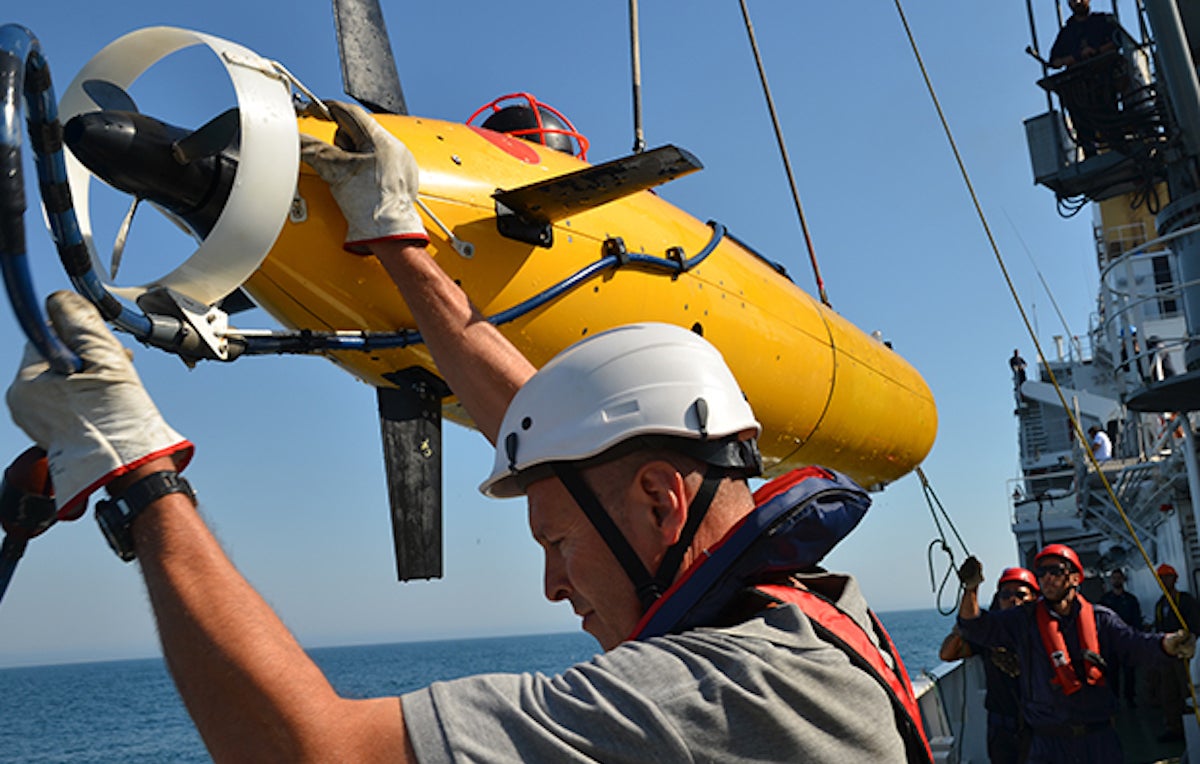Open standards exist for all manner of wireless and terrestrial communications, but so far none has emerged for underwater communications. Below the waves, submarines, autonomous underwater vehicles (AUVs), and undersea sensor stations use a hodgepodge of incompatible proprietary technologies including acoustic, radio, and optical modems.
Manned submarines and many automated subs can surface to communicate over the air, where the bandwidth is much higher, and some submersible AUVs and research stations can be tethered to floating wireless buoys. Yet, there are times when neither option is feasible, and with the huge expansion in AUVs, there’s a growing need for a universal undersea communication standard for persistent mobile communications.
Internet of Underwater Things
Enter NATO, which has a keen interest in reliably communicating beneath the waves, both for military and emergency response purposes. The multinational defense organization recently announced it has adopted a new JANUS digital communications standard for underwater acoustic modems. Deployed as an official NATO standard called STANAG 4748 (PDF), JANUS will be implemented on all NATO vessels.
As detailed by IEEE Spectrum, the open source, GPL-licensed JANUS standard uses acoustic modems. Acoustic technology has a much longer range than higher-bandwidth optical systems, which top out at 100 meters, and RF radios, which can’t do much better.
JANUS, which is named after the Roman god of gateways, has been tested at 900Hz to 60kHz frequencies at distances of up to 28 kilometers. However, it’s optimized for sending data underwater at up to 10 km.
JANUS assigns the 11.5 kHz band for initial discovery, and defines a procedure for handshaking, synchronization, and 80bps data transmission using 56-bit packets. Once synchronized, the systems can then switch to a different frequency or protocol shared by both parties, depending on bandwidth, distance, or security requirements.
JANUS includes a standard modulation encoding scheme called Frequency-Hopped Binary Frequency Shift Keying (FH-BFSK) that describes how acoustic waveforms are encoded. It also provides redundancy checking for reducing errors caused by interference from varying water temperatures, currents, and Doppler effects caused by motion. JANUS can also communicate with wireless enabled buoys to extend the network.
The technology was developed by a team led by NATO principal scientist João Alves at NATO’s Centre for Maritime Research and Experimentation (CMRE) in La Spezia, Italy and is sponsored by NATO’s Allied Command Transformation group.
IEEE Spectrum quotes Chiara Petrioli, a researcher and JANUS project collaborator at La Sapienza, the University of Rome, as saying that JANUS could evolve into an “Internet of Underwater Things” — a network of sensor systems, AUVs, and buoys that could connect the underwater world.
The NATO announcement cites potential JANUS applications including harbor protection, maritime surveillance, mine detection, archaeology, and surveys for offshore wind farms and pipelines. Other examples include search and rescue operations and real-time underwater sensor networks, as well as enabling AUVs to more quickly report oil leaks. JANUS modems are also sufficiently small and affordable to be worn by scuba divers.
BeagleBone drives first JANUS acoustic modem
Linux is found in many AUVs, such as the SeaBED and Bluefin-21, so we wondered if it might be involved in the JANUS, as well. As it turned out, one of the first JANUS acoustic modems was built around Linux code running on a BeagleBone Black. The hacker board, which came in fifth place out of 98 in our recent open-spec SBC reader survey is the controller behind the first commercial, JANUS-compatible acoustic modem: the SeaModem.
One of the early JANUS tests conducted by Petrioli and other La Sapienza researchers is described in this research paper (PDF). The researchers used the SeaModem, developed by AppliCon, a spinoff of the University of Calabria, connected to a BeagleBone running Linux-based JANUS code.
The SeaModem consists of a power board with an amplifier and ceramic transducer, among other circuitry, as well as a DSP board with a digital signal processor, real-time clock, and audio codec. The device communicates via a UART interface with the BeagleBone, which is here augmented with a second audio codec module. GPIO connections between the boards enable improved signal-to-noise ratio.
The Linux stack included JANUS compatible networking software called Sunset, developed by La Sapienza and a spinoff called WSENSE. Sunset, which also runs on ARM modules such as Gumstix boards, can seamlessly switch between the JANUS acoustic link and a higher-bandwidth proprietary modulation scheme.
The system was tested in San Diego aboard a highly modified Sea Robotics USV-2600 autonomous catamaran called the Gemellina USV. The sensor-laden catamaran navigates using an Ubuntu-driven computer.
The La Sapienza team added a module mounted under the Gemellina’s hull comprising the SeaModem, BeagleBone, audio codec, and other gear packed inside a waterproof aluminum case. The experiment tested JANUS communications and handoffs to proprietary links between the Gemellina and three stationary underwater JANUS nodes. La Sapienza concluded that JANUS could be used as “as a reliable robust channel to exchange short control messages,” and can capably switch to a faster communication protocol.
One problem with acoustic communications is the potential risk to marine animals. Yet, NATO claims that biologists were consulted in JANUS’ development to ensure limited interference.
Even if JANUS is safe to marine life, there is no guarantee that underwater communications vendors will sign on. Still, the large scope of potential NATO contracts is already ramping up commercial development. The technology is relatively affordable, and in most cases, it’s not intended to replace other technologies, but to augment them. Vendors can therefore add JANUS as an optional link for emergency rescue and collaborative projects.
In other words, it’s likely JANUS will emerge as the forerunner of an underwater Internet. It’s also likely that Linux will play a large role in making it happen.
Connect with the embedded community at Embedded Linux Conference Europe in Prague, October 23-25. Register now!



